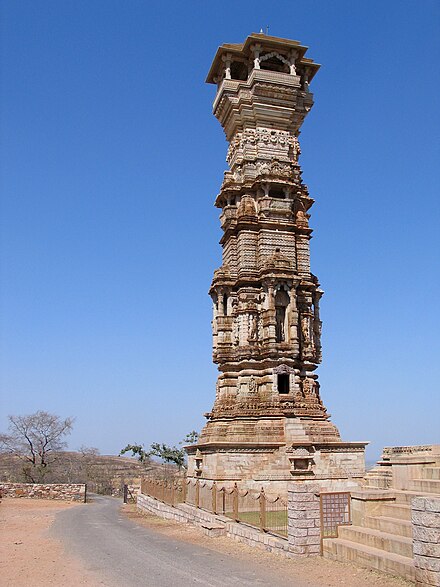Stambha

| Part of a series on |
| Hindu mythology |
|---|
 |
| Sources |
| Cosmology |
| Deities |
| Personalities of the Epics |
| Hinduism Portal |
| Part of a series on |
| Jainism |
|---|
 |
A stambha (Sanskrit: स्तम्भ, romanized: stambha) is a pillar or a column employed in Indian architecture.[1] A stambha sometimes bears inscriptions and religious emblems.[2]
Religion
In Hindu mythology, a stambha is believed to be a cosmic column that functions as a bond, joining heaven (Svarga) and earth (Prithvi). A number of Hindu scriptures, including the Atharva Veda, feature references to stambhas.[3] In the Atharva Veda, a celestial stambha has been described as an infinite scaffold, which supports the cosmos and material creation.
In the legend of Narasimha, an avatara of Vishnu, the deity appears from a stambha to slay the asura Hiranyakashipu. The stambha has been interpreted to represent the axis mundi in this myth by Deborah A. Soifer.[4]
Architecture
Stambhas are popularly employed in Indian architecture. Different stambhas serve different purposes, including the following:
- A dhvaja stambha (flagstaff tower) is placed opposite the main shrine, on an axis with the main deity.
- A kirti stambha (glorious tower) and vijaya stambha (victory tower) are erected to commemorate victories.
- The most well-known stambhas of India are the Ashoka Stambha (Pillars of Ashoka) — erected during the reign of Ashoka, spread across the subcontinent, bearing different types of royal edicts.
- The Adi Purana — a huge manastambha — stands in front of the samavasarana of the tirthankaras, which is regarded to causes entrants to a samavasarana[clarification needed] to shed their pride.[5]
Gallery
-
Kirti Stambha of Hutheesing Jain Temple
-
The stambha of Parshwanath Jain Mandir, Belgachhiya
See also
- Related topics
- Other similar topics
References
- ^ Walker, Benjamin (9 April 2019). Hindu World: An Encyclopedic Survey of Hinduism. In Two Volumes. Volume I A-L. Routledge. p. 199. ISBN 978-0-429-62465-0.
- ^ Jarzombek, Mark M.; Prakash, Vikramaditya (4 October 2011). A Global History of Architecture. John Wiley & Sons. p. 806. ISBN 978-0-470-90248-6.
- ^ Vatsyayan, Kapila (1997). The Square and the Circle of the Indian Arts. Abhinav Publications. p. 27. ISBN 978-81-7017-362-5.
- ^ Soifer, Deborah A. (1 January 1991). The Myths of Narasimha and Vamana: Two Avatars in Cosmological Perspective. SUNY Press. p. 156. ISBN 978-0-7914-0799-8.
- ^ Shah, Umakant Premanand (1987), Jaina-rūpa-maṇḍana: Jaina iconography, Abhinav Publications, ISBN 81-7017-208-X
Sources
- Dictionary of Hindu Lore and Legend (ISBN 0-500-51088-1) by Anna Dallapiccola.



